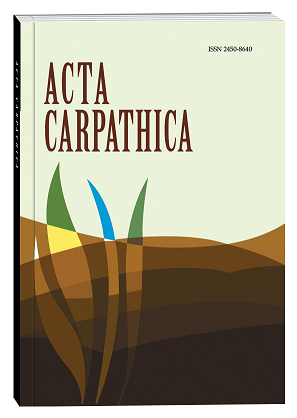THE SYNERGISTIC IMPACT OF BETAINE, TAURINE, AND MYO-INOSITOL ON THE BIOCHEMICAL BLOOD PROFILES OF LAYING HENS UNDER HEAT STRESS CONDITIONS
DOI:
https://doi.org/10.32782/2450-8640.2024.2.2Keywords:
heat stress, laying hens, betaine, taurine, myo-inositol, biochemical indicators of blood, metabolic processes, enzymatic activity, proteins, lipid metabolism.Abstract
In modern poultry farming, heat stress is one of the main factors negatively affecting the productivity of laying hens. Elevated temperatures lead to changes in metabolic processes, reflected in disruptions of blood biochemical indicators, specifically enzyme activities, protein, lipid, and metabolite levels. Feed supplements with antistress properties, such as betaine, taurine, and myo-inositol, hold promise for reducing the adverse effects of heat stress on poultry. Therefore, the study aimed to evaluate the impact of betaine, taurine, and myo-inositol supplements on the biochemical parameters of the blood of laying hens exposed to heat stress and to establish ways to prevent its negative effects. In the study, 15 laying hens were used, divided into 2 groups: 1st group – control (С), 2nd group – experimental (Е), whose hens received betaine in the amount of 0.5 g/kg of feed, taurine in the amount of 5 g/kg of feed and 2 g/kg of myo-inositol from the dry matter of the feed. The study included two stages: in the first, which lasted seven days, the chickens were kept at a temperature of 20 °C, which was taken as thermoneutral conditions, and in the second, the air temperature in the vivarium was raised to 30 °C for 6 hours every day for a week. After each stage, blood samples of the birds were taken for further research. This study established that these supplements help maintain biochemical stability under HS conditions, particularly by stabilizing protein and lipid metabolism, improving oxidative defense markers, and reducing overall metabolic stress on the body. The results indicate the feasibility of using betaine, taurine, and myo-inositol to prevent stress-related disorders in laying hens under production conditions.
References
1. Bohler M.W., Chowdhury V.S., Cline M.A., Gilbert E.R. Heat stress responses in birds: A Review of the neural components. Biology (Basel). 2021. 10 (11). 1095. DOI: 10.3390/biology10111095.
2. Kim D.H., Lee Y.K., Kim S.H., Lee K.W. The impact of temperature and humidity on the performance and physiology of laying hens. Animals (Basel). 2021. 11 (1). 56. DOI: 10.3390/ani11010056.
3. Xin H., Harmon J.D.. Temperature and humidity stress index for laying hens. Livestock industry facilities and environment: Heat stress indices for livestock. Agriculture and Environment Extension Publications. Book 163, Iowa State University. 1998.
4. Kim D.H., Lee Y.K., Lee S.D., Kim S.H., Lee S.R., Lee H.G., Lee K.W. Changes in production parameters, egg qualities, fecal volatile fatty acids, nutrient digestibility, and plasma parameters in laying hens exposed to ambient temperature. Front Vet Sci. 2020. 7. 412. DOI: 10.3389/fvets.2020.00412. eCollection 2020.
5. Perederiy D.B. The influence of heat stress on the antioxidant protection glutathione link and the content of lipid peroxidation products in chicken liver. Bìol Tvarin. 2023. 25 (4). 51–57. DOI: 10.15407/animbiol25.04.051.
6. Li C., Wang Y., Li L., Han Z., Mao S., Wang G. Betaine protects against heat exposure–induced oxidative stress and apoptosis in bovine mammary epithelial cells via regulation of ROS production. Cell Stress & Chaperones. 2019. 24 (2), 453–460. DOI: 10.1007/s12192-019-00982-4
7. Baliou S., Adamaki M., Ioannou P., Pappa A., Panayiotidis M.I., Spandidos D.A., Christodoulou I., Kyriakopoulos A.M., Zoumpourlis V. Protective role of taurine against oxidative stress. Mol Med Rep. 2021. 24 (2). 605. DOI: 10.3892/mmr.2021.12242.
8. Gonzalez-Uarquin F., Rodehutscord M., Huber K. Myo-inositol: its metabolism and potential implications for poultry nutrition-a review. Poult Sci. 2020. 99 (2). 893–905. DOI: 10.1016/j.psj.2019.10.014.
9. Petrovska I.R., Salyha Y.T., Vudmaska I.V. Statistical methods in biological research: educational and methodological manual. Agrarian Science. Kyiv. 2022. 172.
10. Oh R.C., Hustead T.R., Ali S.M., Pantsari M.W. Mildly Elevated Liver Transaminase Levels: Causes and Evaluation. Am Fam Physician. 2017. 96 (11). 709–715.
11. Iluz-Freundlich D., Zhang M., Uhanova J., Minuk G.Y. The relative expression of hepatocellular and cholestatic liver enzymes in adult patients with liver disease. Ann Hepatol. 2020. 19 (2). 204–208. DOI: 10.1016/j.aohep.2019.08.004.
12. Tóthová C., Sesztáková E., Bielik B., Nagy O. Changes of total protein and protein fractions in broiler chickens during the fattening period. Vet World. 2019. 12 (4). 598–604. DOI: 10.14202/vetworld.2019.598-604.
13. Rashidi A.A., Gofrani Iv. Y., Khatibjoo A., Vakili R. Effects of dietary fat, vitamin E and zinc on immune response and blood parameters of broiler reared under heat stress. Res J Poult Sci. 2010. 3(2). 32–38. DOI: 10.3923/ rjpscience.2010.32.38.
14. Hassan S., Habashy W., Ghoname M., Elnaggar A. Blood hematology and biochemical of four laying hen strains exposed to acute heat stress. Int J Biometeorol. 2023 Apr. 67 (4). 675–686. DOI: 10.1007/s00484-023-02445-z.
15. Yuzviak M. Influence of Zinc, Selenium and Germanium citrates nanoparticles on hematological and biochemical parameters of rabbits under moderate heat stress. Bìol Tvarin. 2024. 26 (2). 47–55. DOI: 10.15407/animbiol26.02.047.








